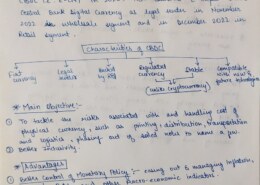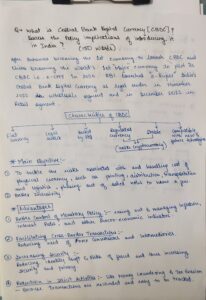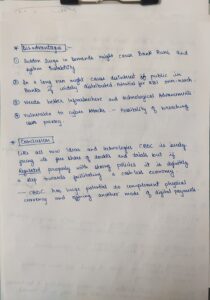What is the exchange rate that is flexible? Describe the causes of the Indian rupee’s growth and decline in relation to the US dollar. (Answer in 200 words)
NPA stands for Non-performing assets (NPAs). As per the Reserve Bank of India NPAs are loans or advances, due for more than 90 days. In other words, an asset becomes non-performing when it stops generating income for the bank. In case of agricultural advances cropping seasons are taken into cRead more
NPA stands for Non-performing assets (NPAs). As per the Reserve Bank of India NPAs are loans or advances, due for more than 90 days. In other words, an asset becomes non-performing when it stops generating income for the bank. In case of agricultural advances cropping seasons are taken into consideration instead of 90 days. Increasing NPAs is not a good sign for the banking sector and economy as it shows the inability of people to repay the loan.
Types of NPAs
Non-performing assets are categorized into various types based on specific criteria.
1. Substandard Assets: The assets have remained NPA for a period less than or equal to 12 months.
2. Doubtful Assets: Assets that have remained in the substandard category for 12 months.
3. Loss Assets: Assets where loss has been identified by the bank or external auditors or the RBI, but the amount has not been written off.
Measures Taken to Control NPAs by the Government
1. Insolvency and Bankruptcy Code (IBC), 2016:
It aims to improve the ease of doing business and a single-step solution to resolve insolvency issues.
To oversee the implementation of the law and insolvency professionals.
The incorporation of the IBC has significantly improved the recovery rates of bad loans by providing quicker resolution and restructuring of assets.
2. Asset Quality Review (AQR):
The RBI introduces an AQR to identify stressed assets in the banking system. This exercise focused on bringing transparency and improving the recognition of NPAs on the bank’s books.
3. Strategic Debt Restructuring (SDR), 2015:
If corporations are unable to repay their bank loans, the banks have the option to convert part or all of the loans into equity shares.
4. Mission Indradhanush:
This initiative was launched to revise the functioning of PSBs and identify issues like accountability, governance, and the overall condition of the banking sector.
It includes appointing professionals to major positions, empowering risk control measures, and improving the efficiency of bank operations.
5. Debt Recovery Tribunal (DRT), 2013:
It is governed by the Recovery of Debt Due to Banks and Financial Institutions Act, of 1993.
The aim was to shorten the time needed for case settlements.
6. Joint Lenders Forum (2014):
This measure is implemented to prevent the situation where a loan is taken from one bank to repay loans from other banks.
7. 5:25 Rule (2014):
It is also known as the Flexible Restructuring of Long Term Project Loans to Infrastructure and Core Industries and involves the refinancing of long-term projects.
8. Corporate Debt Restructuring (2005):
It minimizes the company’s debt burden by extending the repayment period and lowering the interest rates.
9. Asset Reconstruction Companies (ARC)
This measure helps in recovering value from distressed loans without going through the time-consuming process of court.
10. The SARFAESI Act (Securitization and Reconstruction of Financial Assets and Enforcement of Security Interest Act), 2002:
This act allows banks and financial institutions to auction residential or commercial properties to recover loans of defaulters.
The amendment in 2016 aimed to encourage banks to take possession of collateral security and sell them without the interference of courts.
11. Bad Bank – National Asset Reconstruction Company Limited (NARCL):
The government suggested setting up a ‘bad bank’ to manage and dispose of stressed assets of banks.
It will facilitate the aggregation and resolution of large-value NPAs along with the India Debt Resolution Company Limited (IDRCL).
12. Empowering Governance in Banks:
It includes the establishment of the Banks Board Bureau (BBB) to recommend appointments of directors and ensure the professionalization in bank management.
Improved investigation and accountability norms to avoid the reoccurrence of large frauds.
13. One-Time Settlement Schemes:
Banks have been encouraged to offer one-time settlement schemes to borrowers, especially in the MSME sector, to expedite the recovery process.
14. MSME Debt Restructuring:
The government and RBI have provided relief to the MSME sector by allowing the restructuring of their stressed assets without devaluing them.
See less




Flexible exchange rate is also called as floating exchange rate which is a monetary policy. In this value of currency is determined by the foreign exchange market, this policy is in contrast with the fixed exchange rate in which value of currency is fixed by the government or the central bank of theRead more
Flexible exchange rate is also called as floating exchange rate which is a monetary policy. In this value of currency is determined by the foreign exchange market, this policy is in contrast with the fixed exchange rate in which value of currency is fixed by the government or the central bank of the country.
The value of currency can fluctuate because of the market forces such as supply and demand forces in the market.
Appreciation of the Indian rupee in relation to the US Dollar means the rupee has become stronger against the dollar. We can buy more dollars with rupees than before.
Factors leading to appreciation are as follows:-
1. Increase in the value of Indian Rupee related to the US dollar.
2. Rupee becomes stronger against the dollar.
3. Eg.The value of 1 US Dollar decreased from ₹75 to ₹70.It means now we can buy $1 with ₹70 for which we used to pay ₹75 before.
Depreciation of the Indian rupee is the opposite of appreciation of rupee.In this the Rupee becomes weaker in relation to the US Dollar, we will get less dollars with rupees now.
Factors leading to depreciation of the Indian rupee are as follows:-
1. Decrease in the value of Indian Rupee related to the US Dollar.
2. Rupee has become weaker against the dollar.
3. Eg. The value of Doller has increased from ₹70 to ₹75. It means earlier we used to pay ₹70 to buy $1 but now we have to pay ₹75 for the same.
The appreciation and depreciation can be caused by many different factors such as Trade balances, inflation rate, political instability, export-import, interest rates, foreign investment etc.
See lessAppreciation of rupees leads to increase in purchasing power of Indian consumers but negatively impacts export and import of the country whereas depreciation benefits the export-import.